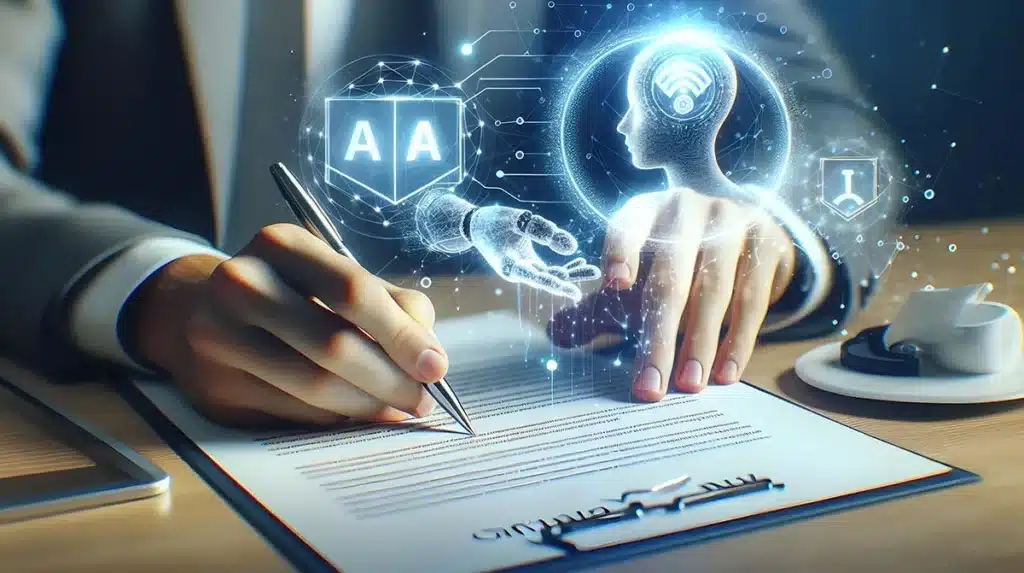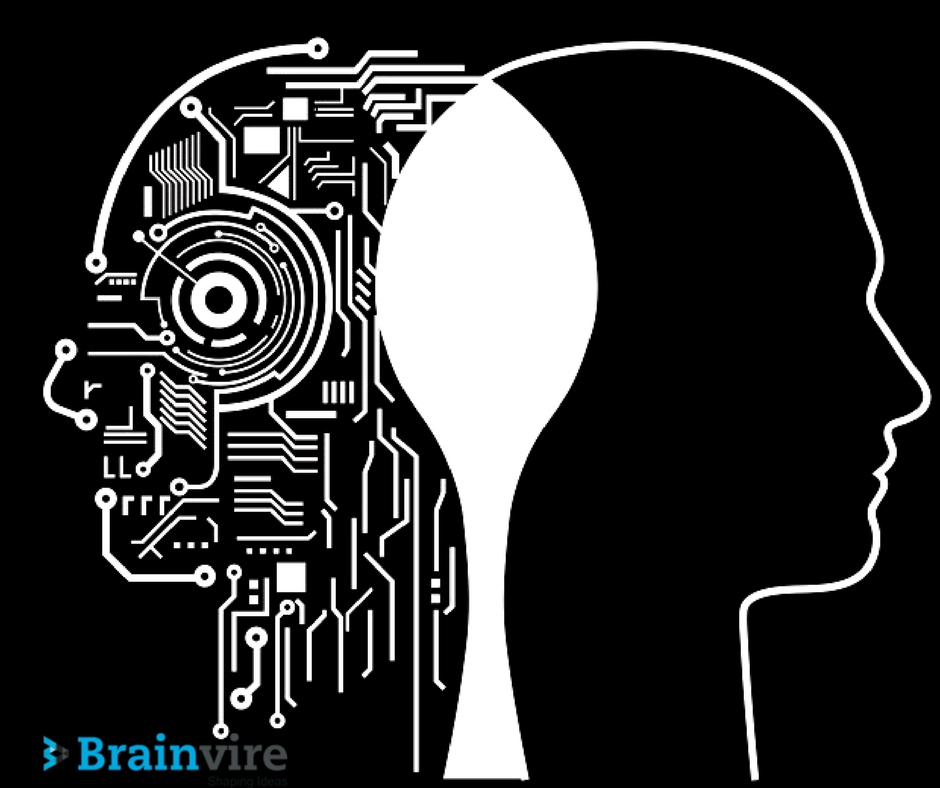Contracts can make or break deals, partnerships, and even business units. Yet for decades, reviewing them has been one of the job’s most tedious and frustrating parts. Legal teams and business professionals spend hours combing through dense legal language, hunting for key clauses, spotting risks, and ensuring compliance. The margin for error is razor-thin. One missed detail could lead to financial losses, disputes, or damage to reputation.
The 2023 Enterprise Legal Management Report found that in-house counsel spend an average of 4.5 hours daily on manual contract review. That’s nearly half the workday consumed by repetitive tasks. Generative AI is making its way into transforming the landscape.
Instead of slogging through pages of legal text, AI can quickly analyze contracts, highlight risks, suggest revisions, and even generate draft clauses. It doesn’t replace human judgment but acts like a mighty co-pilot, speeding up approvals, minimizing risk, and giving professionals the freedom to focus on strategy and high-value work.
Understanding the New Paradigm: Generative AI vs. Traditional Automation
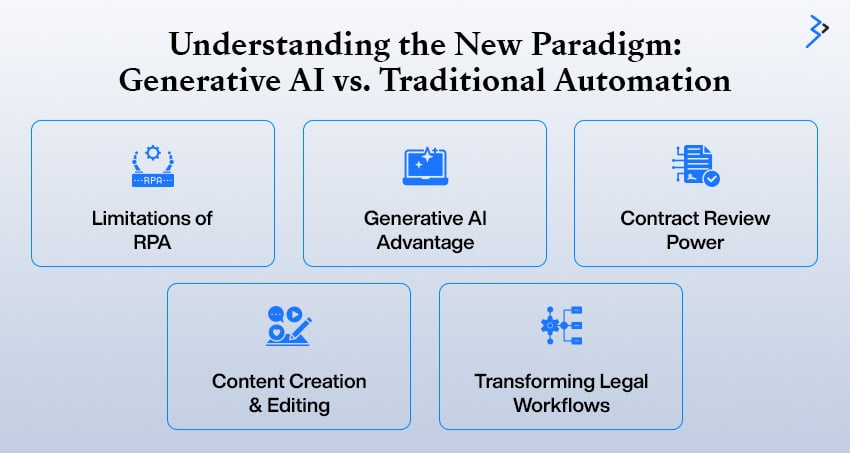
Traditional automation tools like RPA are good at repetitive tasks, such as finding specific words or copying data, but they can’t understand context or meaning. For example, if you asked if a contract clause is risky, they would highlight a word instead of interpreting its significance.
Generative AI, on the other hand, uses large language models trained on extensive datasets (including legal documents). With the help of Generative AI Development Services, it can understand language, recognize patterns, interpret complex legal terms, and create new content tailored to specific business or legal contexts.

Here’s what that looks like in contract review:
- Understand legal nuances: Identify subtle risks in clauses, not just keywords.
- Create and redline content: Suggest edits, draft new clauses, or generate entire contracts.
- Reason and plan: Break down high-level tasks, like “find all high-risk clauses”, into smaller, actionable steps.
The result? Legal teams move from manual, time-consuming reviews to more brilliant, faster workflows. In fact, research shows AI can cut contract review and drafting time by 70–80%, freeing teams to focus on higher-value strategic work.
The Problem with Traditional Contract Workflows
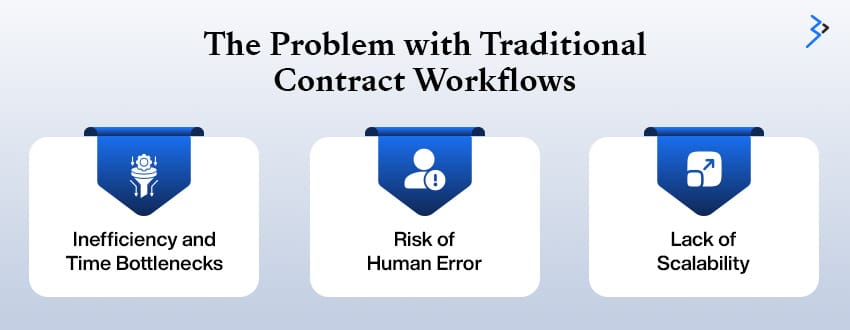
The legal industry has long been a bastion of manual, document-intensive work. Traditional contract review processes encounter three significant challenges that generative AI can effectively tackle:
Inefficiency and Time Bottlenecks
Manual contract review can feel like running in slow motion. Teams spend countless hours reading, re-reading, and cross-checking documents before a deal can progress. Delays create a ripple effect throughout the business, slowing sales cycles, stalling vendor onboarding, and hindering partnerships that should move forward quickly.
Risk of Human Error
Even the most detail-oriented professional can miss something when reviewing hundreds of pages of legal text. A single overlooked clause, such as a hidden liability or an inconsistent payment term, can have serious financial or legal consequences. Human error in contract review doesn’t just waste time, it can put the entire business at risk.
Lack of Scalability
As organizations grow, the contract volume multiplies. Suddenly, what was manageable for a small team becomes overwhelming. Hiring more lawyers is not always sustainable, and relying only on manual reviews means important agreements take too long to finalize. The lack of scalability slows the legal process and keeps the business from operating at the speed it needs to compete.
Read More – Generative AI: Redefining the Boundaries of Traditional Machine Learning
Generative AI in Action: Transforming the Contract Lifecycle
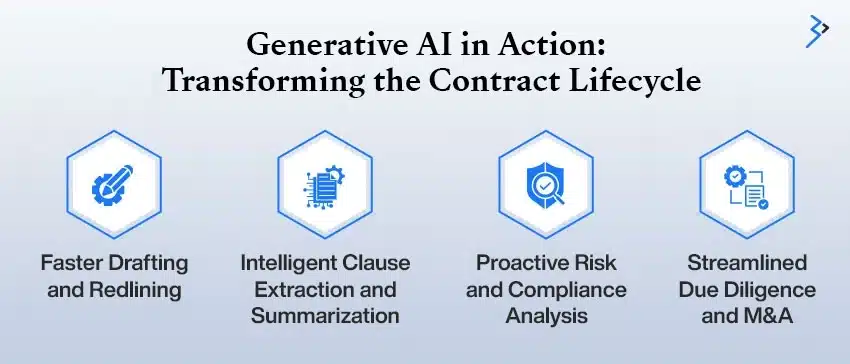
The power of generative AI lies in its ability to address these challenges across every stage of the contract lifecycle.
1. Faster Drafting and Redlining
Gone are the days of creating a new contract from scratch. Generative AI can draft initial contract templates based on a company’s standard clauses and legal playbooks and generate new clauses to address specific needs. The capability is game-changing. During negotiations, the AI can suggest redlines and alternative language that align with company policy, accelerating the back-and-forth process. With advanced AI services, organizations can leverage these intelligent tools to enhance accuracy and speed. For instance, an AI tool can draft a full Non-Disclosure Agreement (NDA) in minutes, saving immense time in the initial creation phase.
2. Intelligent Clause Extraction and Summarization
AI can quickly summarize contracts and highlight important information, saving legal and business teams a lot of time. For example, instead of manually searching for specific clauses or key dates, they can use AI to find everything they need in minutes. A study by Thomson Reuters shows that this can save lawyers around 240 hours each year by automating tasks like document review and contract analysis, letting them focus on the most critical parts of the agreement.
3. Proactive Risk and Compliance Analysis
Generative AI helps find risks in contracts that humans might miss. It checks clauses against company policies and legal standards and can spot issues that could lead to disputes. For instance, if a clause unfairly shifts liability to your company, the AI will flag it for a lawyer to review. It also updates templates automatically with regulation changes, making it easier to stay compliant.
4. Streamlined Due Diligence and M&A
During mergers and acquisitions, time is everything. Teams often need to review thousands of contracts under immense pressure, looking for risks and obligations that could make or break the deal. Manually doing this is not only slow but also prone to error.
AI changes the game. Instead of flipping through contracts one by one, it can scan and analyze them in minutes, flagging critical clauses, highlighting risks, and creating a clear, consistent summary for decision-makers. The result? Faster due diligence, reduced costs, and sharper insights, all delivered with greater accuracy than traditional methods.
Read More – Elevate your Adobe Experience Manager Sites Website with Generative AI Chatbots
Overcoming the Challenges of Adoption

While the promise of generative AI is clear, its implementation is challenging. Organizations must prepare to address these issues to ensure a smooth and successful transition.
Data Quality and Privacy: The quality of the data used to train AI models determines their effectiveness. Poor-quality or inconsistent data can lead to inaccuracies and inefficiencies. Moreover, legal contracts contain highly sensitive and confidential information. Using a secure, private, and well-curated dataset for training your AI is crucial. Many companies prefer to train AI models on their internal contract repositories rather than rely on public data.
The “Lack Box “Problem: Some AI models operate as “lack boxes, “providing answers without explaining their reasoning. This is a significant issue in legal work, where accountability and reasoning are essential. Organizations should select AI solutions that use explainable AI (XAI) to explain why they label a clause as risky or propose a specific term.
The Need for Human Oversight: The narrative is about a shift in the role of legal professionals due to generative AI, which will handle repetitive tasks like contract review. Lawyers are enabled to concentrate on strategic, creative, and empathetic tasks. Human oversight remains crucial to ensure accuracy in AI-generated outputs, with expert review necessary for legally sound final documents.
Integration and Cost: Setting up a new AI system can be tricky and expensive. Ensuring it works well with existing tools, like CRMs and ERPs is important. Organizations should have a solid plan for adding AI to their usual processes and be ready to invest in technology and skilled people. A report from Secretariat and ACEDS found that 53% of organizations are already seeing a return on their AI investments, showing that the long-term benefits can outweigh the upfront costs.
The Evolving Role of the Legal Professional
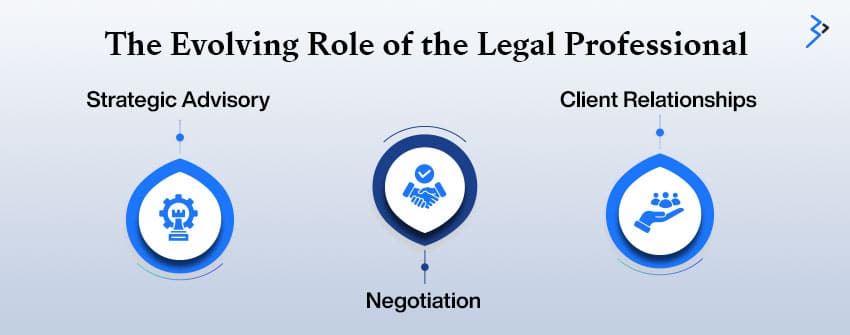
The shift isn’t just about adopting new technology; it’s reshaping the role of legal professionals themselves. Lawyers are moving beyond repetitive, manual tasks to become trusted advisors, skilled negotiators, and strategic thinkers. With AI handling the heavy lifting of contract review and analysis, legal teams can focus on what matters, making sharper decisions, confidently guiding the business, and delivering value far beyond paperwork.
As AI handles the routine, the human legal team can focus on what truly matters:
- Strategic Advisory: Providing high-level counsel to the business on complex legal matters.
- Negotiation: Leveraging human empathy and creative problem-solving to navigate complex deal structures.
- Client Relationships: Building and maintaining strong client relationships requires a human touch.
Organizations are actively transitioning to AI in procurement. By 2027, they expect that AI will assist half of all contracts. Companies that invest in this technology will stay competitive, while those that don’t risk falling behind. Success lies not just in adopting AI but in strategically implementing it. Organizations need a solid data foundation and a clear integration plan, and partnering with experts can help with data integration and model customization.
Conclusion: Partnering for a Smarter Future
The future of contract review has arrived with the help of generative AI. This technology makes it easier and faster to get approvals, reduces risks, and creates a more efficient legal process. It is a helpful tool that handles tedious manual reviews, allowing legal professionals to focus on more complex and important tasks.
At Brainvire, we know that each organization has different needs. We help you develop a clear AI strategy that keeps your data secure and customizes our contract management solutions to fit your specific workflows. With our help, your business can confidently embrace this change, turning an usually slow and difficult process into a competitive advantage. The future of contract review is not just about automating tasks; it’s about using innovative solutions effectively, and now is the time to take advantage of it.
FAQs:-
No. Generative AI is designed to assist, not replace. It handles time-consuming, repetitive tasks like clause extraction, risk flagging, and drafting, while lawyers focus on strategy, negotiations, and critical decision-making.
AI is highly consistent in spotting patterns, risks, and clauses across large volumes of contracts. However, legal work still requires human oversight. Think of AI as a reliable assistant that speeds up the process, while the final judgment remains with the legal professional.
Yes. Generative AI can be trained on your organization’s contract libraries, templates, and compliance rules. Over time, it learns your preferences, ensuring contract reviews and drafts align with your specific standards.
Security is a top priority. Leading AI solutions offer encryption, private cloud or on-premise deployments, and strict access controls, ensuring that sensitive legal data remains protected and compliant with regulations.
Most teams start seeing results within weeks. The improvements compound over time, from faster drafting and quicker approvals to reduced errors and fewer backlogs, leading to a more agile, efficient legal function.
Related Articles
-
Top 20 AI Product Description Generator Tools To Use in 2025
Introduction Artificial Intelligence (AI) is revolutionizing businesses’ operations and transforming processes across industries. Among its most impactful applications are AI Product Description Generator tools, which are reshaping how companies handle
-
Artificial Intelligence – Your Future Predictor Crystal Ball!
You don’t need to hire a tarotcard reader, you yourself can be one. Yes, you can have your own crystal ball which would show your business outcomes without any haze
-
Custom AI Negotiation Assistants: Benchmarking Clauses and Optimizing Outcomes for Every Deal
Negotiation is crucial to the business world; every contract feels like a battle. Traditionally, it has relied on people’s instincts and past experiences, which often means a lot of back-and-forth

